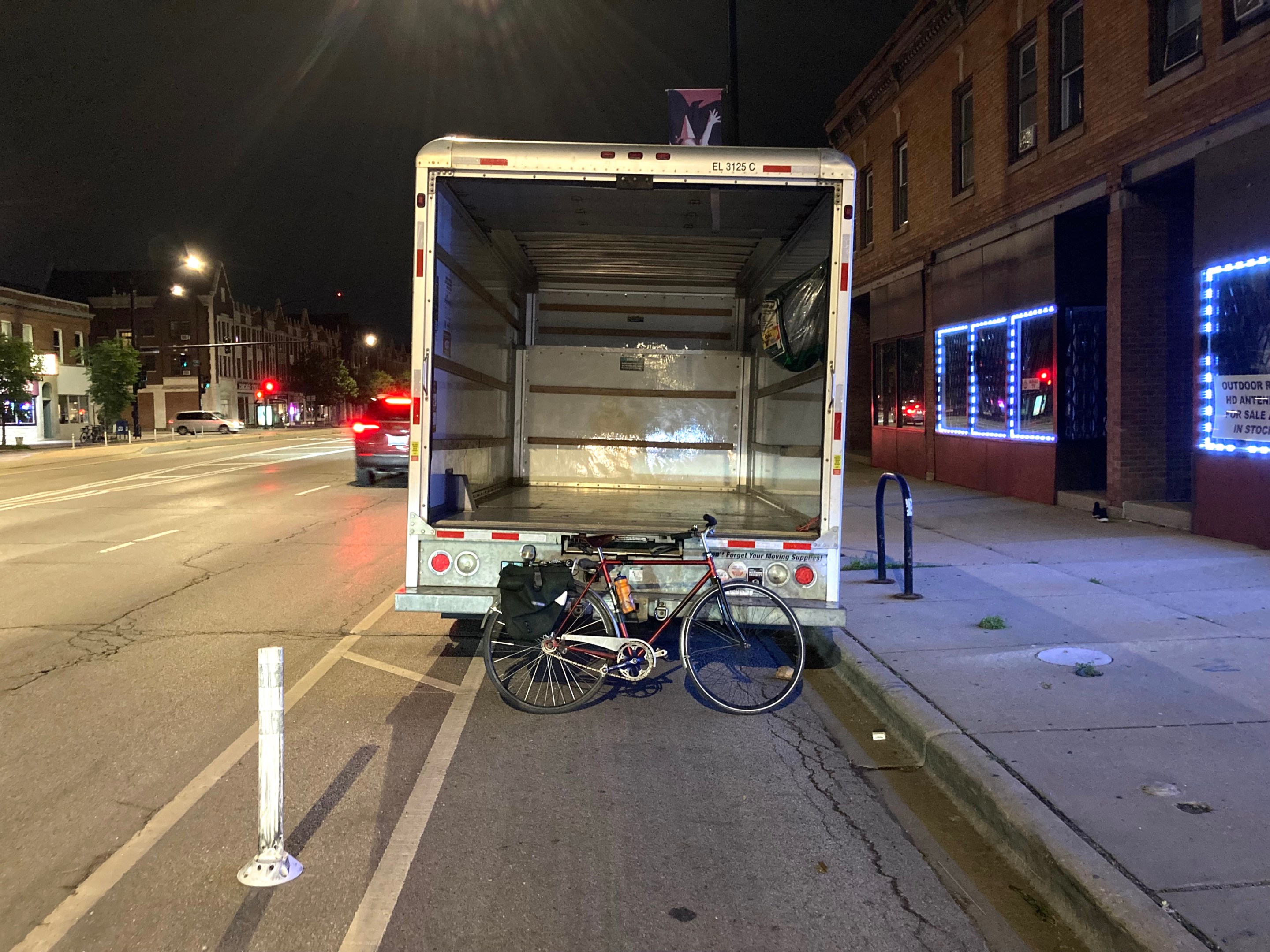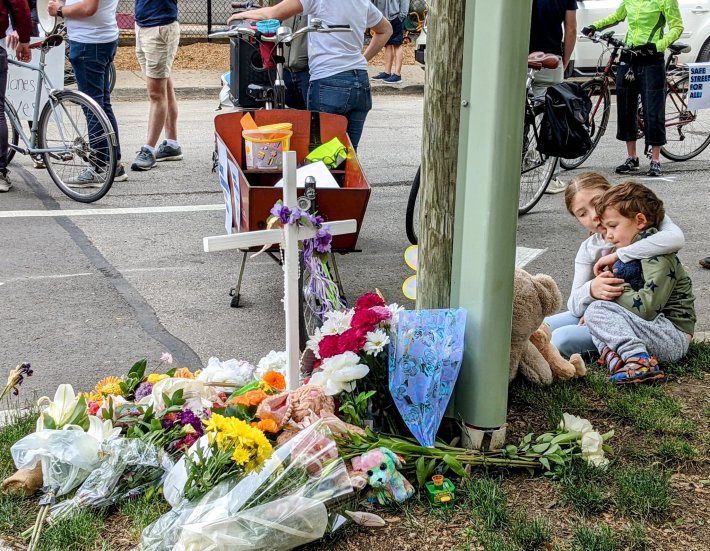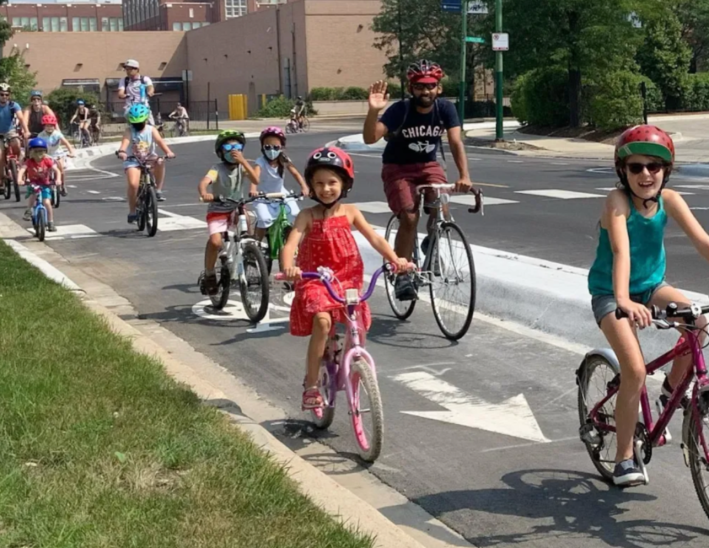CDOT plan to upgrade all “protected” lanes w/ concrete is good. Here’s how to improve it.
5:09 PM CDT on June 29, 2022

A moving truck parked in one of the flexi-post bike lanes on Clark Street in Edgewater. Concrete protection can help prevent illegal parking in bikeways. Photo: John Greenfield
Earlier this month the death of Lily Shambrook, 3, highlighted the fact that when motorists illegally park or drive in bike lanes, there can be tragic consequences. Lily was riding on the back of her mother's bike in a painted bike on Leland Avenue in Uptown when they encountered a ComEd truck parked in the bikeway. After the mother entered the mixed-traffic lane to get around the vehicle, she was clipped by a semi driver, who ran over and killed the toddler.
Many of Chicago's so-called "protected" bike lanes don't offer any real physical protection from drivers, but are simply paint on the road delineated with widely spaced, flimsy plastic posts that are quickly run over by motorists. Partly in response to Lily's totally preventable death, today the city announced that it is taking action to help keep drivers out of bikeways.

The Chicago Department of Transportation today outlined plans to add concrete barriers to all the city’s plastic post-delineated and/or parking-protected bike lanes by the end of 2023. Streetsblog suggested nearly this exact strategy back in March 2022.
The work will be funded by the Chicago Works Capital plan. The project will include 25 miles of bikeways, including 15 miles of existing lanes and ten miles of new bikeways. Incorporating concrete will be the new standard for protected lanes. CDOT’s target is for 70 percent of all protected bike lanes to include curb separation. Remaining bike lanes will be upgraded in 2023.

Mayor Lori Lightfoot said in a statement she sees the upgrades as an opportunity to expand the definition of public safety. “Public safety is not only about our emergency response departments, it's also about creating infrastructure that makes the public way safer for all. By leveraging funds from the Chicago Works Capital Plan, we are excited to kick off the largest bike lane upgrade the city has ever undertaken.”
Transportation chief Gia Biagi stated, "Barrier protected lanes are the best way to make biking a safer and more comfortable transportation option for everyone, and this year we’re adding more than ever,” said CDOT Commissioner Gia Biagi. “We’re making unprecedented safety upgrades to our bikeways network and will continue working with community stakeholders on building neighborhood bike networks to ensure that Chicago is a city where everyone has the option to ride a bike.”
Video of riding in the Jersey Wall-protected bike lane on Wacker, installed as part of a temporary bike detour for the Dearborn bridge rehab project.
The first route to receive concrete protection as a result of this plan will be the half-mile stretch of Kinzie Street between Milwaukee and Wells, Chicago’s first protected bike lane. CDOT says it will use a combination of traditional concrete curbs as well as pre-cast curbs to allow for a quicker and more efficient implementation. The pre-cast curbs will be constructed in various sizes to allow for concrete curb separation on narrower protected bike lanes.
Other lanes on the list to receive concrete barriers this year includes:
- Lake Street – Pulaski to Damen (2.5 miles)
- Logan Boulevard – Rockwell to Diversey (0.6 miles)
- Milwaukee Avenue – Addison to Irving Park, Chicago to Division, and Kinzie to Ohio (about 2 miles total)
- Independence Boulevard – Douglas to Harrison (0.8 miles)
- 119th Street – Ashland to Halsted and Major Taylor Trail (1 mile)
Blue: Existing "protected" bike lanes consisting of paint and posts, in some case parking protection
Purple: Existing bike lanes protected with concrete or plastic curbs and/or end caps
Red: New or upgraded bike lanes with concrete curbs and/or end caps to be built in
It's worth noting that several of these stretches have seen bike fatalities in recent years. For example, on May 4 of this year, a hit-and-run driver fatally struck barista Nick Parlingayan, 22, on his bike at Milwaukee and Kilbourn avenues, on the stretch of Milwaukee between Addison and Irving Park that will be getting concrete. Less than three years earlier in November 2019, a trucker ran over and killed school counselor Carla Aiello, 37, on her bike across the street from the Parlingayan crash.
While concrete barriers around painted bike lanes are a welcome upgrade, I still have concerns about drivers parking in or driving in the lanes. I still remember some years ago using the Harrison Street bike lanes which have concrete barriers around a portion of them, and encountering parked cars within it. This is not news to CDOT and there doesn't seem to be any plan to substantively incorporate this feedback into their designs.
This location has been a problem spot for YEARS and after numerous complaints, the bike lane in front of these businesses are still blocked. @SigchoFor25 what can be done to clear the protected bike lane on Harrison & Clinton? Photo cred @bikelaneuprise pic.twitter.com/PxqR7myf8b
— Harrison St Bike Lane (@HarrisonBikeLn) March 19, 2021
In addition, CDOT should make all concrete protection highly visible, perhaps by painting it bright yellow. Otherwise these curbs can form a tripping and crash hazard for pedestrians and bike riders, which is obviously counterproductive to safety.
And needless to say, the more concrete protected lanes that exist in our city, the more important it will be for them to be scrupulously maintained. As it stands, protected lanes often have terrible pavement, are filled with debris, and/or aren't plowed promptly after snowfalls.
The main downside of CDOT's plan is that bike lanes that currently lack even plastic posts will still remain paint-only, which does very little to encourage "normal" people (non-enthusiasts) to ride bikes.
We are also behind on the goal of creating a bike lane network. A bike route is only as safe as its weakest link. If riding to a destination involves using a safe, comfortable concrete-protected bike lane, but also includes less secure, more scary stretches with no physical protection, "interested-but-concerned" bike riders may choose a different travel mode instead. CDOT's plan is certainly a step in the right direction, yet there's much more we could be doing to improve bike lane design and safety.
Noted the Active Transportation Alliance in a statement, "The announcement comes after years of grassroots advocacy calling for more robust barriers for Chicago’s bikeways, and recent mobilization efforts in response to a devastating string of fatal crashes, including four that tragically took the lives of children."
But ATA also echoed Streetsblog's concern that much more needs to be done. "Our advocacy for a connected and protected bike network will continue. We know huge gaps will remain in Chicago’s protected bike lane network, and we know we have yet to unlock the health, sustainability, and equity benefits more biking can bring our communities... We look forward to continuing to fight alongside all of you for a connected and protected bike network that serves all Chicagoans."
Stay in touch
Sign up for our free newsletter
More from Streetsblog Chicago
Johnson appoints one West Side pastor to CTA board, then nominates another West Side pastor for RTA board
Supporters argue that, despite his lack of transit expertise, Ira Acree’s social justice experience and political connections could be an asset for the RTA board.
Today’s Headlines for Thursday, April 26
The de-facto ban on riverwalk biking is back. What should we do about it?
In the short term, new signage is needed to designate legal areas for cycling on the path. In the long term CDOT should build the proposed Wacker Drive protected bike lane.


